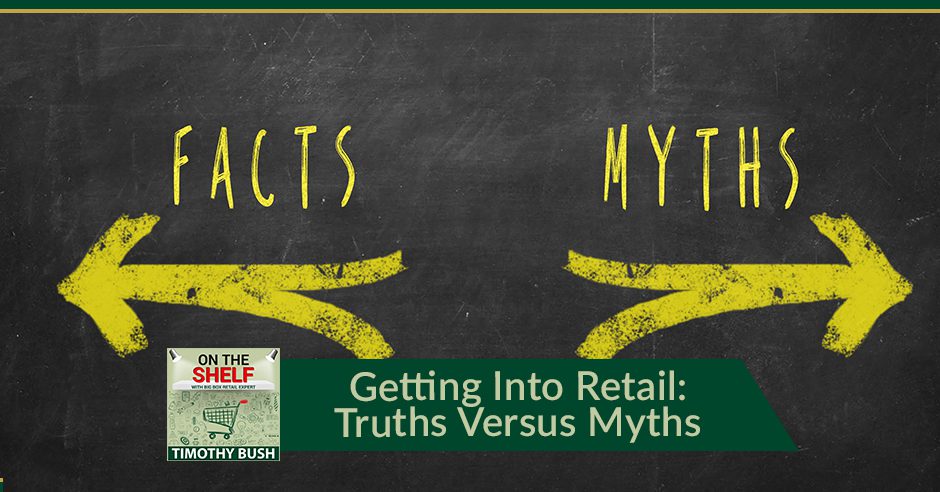
Getting into retail and securing a spot in the retail big leagues is something many entrepreneurs dream about. Have you ever imagined seeing your products on the shelves of a big box retailer but wondered just how to get your product ready and get placement for them? You probably have all these scenarios in your mind about what could go wrong. On today’s podcast, Timothy Bush examines what scares people about getting their products into retail and busts some myths about them.
—
Listen to the podcast here
Getting Into Retail: Truths Versus Myths
How is it going? I know it’s been a while since we had a show and we published one with Azhelle Wade. I hope you enjoyed that. I didn’t get a chance to talk to you and find out how you’re doing. What’s going on in your life? How are you dealing with the whole COVID thing? I know that people are going crazy. There’s a lot of anxiety out there because people don’t know what’s going to happen. What’s happening now? I’m tired of sitting in my house. I’m tired of wearing a mask. I’m tired of doing all these things. I read an article that said if you’re affluent, meaning if you make decent money, the majority of those people are back to work because they said 60% of college graduates can do their job completely from home. Whereas only 20% of non-college grads can do their job from home. Their jobs require them to be there.
In a sense, if you have a job, if you’re a college graduate, if you’re more affluent, if you have a computer, the pandemic is not affecting your financial situation. If you have to get out there, if you have to physically do stuff and be out there, it is affecting it. Here’s a great thing. We’re entrepreneurs. This is what we were built for. When things change, when things shift, we can shift with them. We can change what we’re doing, adapt what we’re doing, make it fit what’s going on in the market. At TLB, our business has been growing since March 2020. We’re busier now than we’ve ever been. The reason is that entrepreneurs understand that in a crisis, you have to push forward. You cannot sit back and wait for things to smooth out because if you do, if you wait, at the end, you’re going to find yourself way behind.
I deal with a lot of entrepreneurs. Most of who I work with are entrepreneurs that are trying to get their products into retail, trying to get their products off the ground. That’s what we deal with. Those people are putting their heads down and getting busy. I hope that you are also doing that. I hope that you’re putting your head down. I hope that you’re pushing forward during this time. If you are, what will happen is when this thing does smooth out, whatever that looks like, you will be so much further ahead than all those people that said, “I’m going to wait it out. I’m going to see what happens.” It’s happening. It’s not about seeing what’s happening or seeing what’s going to happen. It’s happening right now. What’s going on right now is our life. This is what’s going on in our life right now. We can’t stop. We can’t pause. We can’t wait. We have to take it and move it forward.

I hope you are doing that. That’s my wish for you. I’d love to hear from you and open a discussion about what you’re doing, how you’re doing it, how you’re making it through this time and what it’s going to look like on the other end. I don’t know about you, but I have a feeling that New Year’s Eve is going to be the New Year’s Eve to end all New Year’s Eve. It is going to be a boom because people are ready for this year to be over and gone. It doesn’t matter what’s going on with COVID at the time. It doesn’t matter what’s going on or what happened with the election. People are ready to kick 2020 out the door and slam the door shut. New Year’s Eve, whether you’re going to hold it in your house with family or not is going to be epic. I’m going to be right there with everybody because I’m ready for 2020 to be out and see what’s next, what’s coming. I can’t wait to get back on a plane, go somewhere, do some business, see some people outside the country.
Reach out. Let’s talk about it. I’m interested to know what’s going on with you and how things are going. We’re going to answer some questions. If you’re in my private Facebook group, On The Shelf “Now”, you would have seen this post, but I put out a myth busters’ post. I wanted to find out what’s scaring you about getting your products into retail. I did a Facebook Live. If you want to go to On The Shelf “Now” and join that group and watch the Facebook Live, you’ll see it. It’ll probably be similar to what we’re going to talk about now. For all of you that are not in my Facebook group, I wanted to run all these scenarios by you that people put out there and talk through the answers so that you would have that as well.
Negotiation
The first one was posted by a guy named Jack. He lives in Australia. He had three things. The negotiation is one thing that scares him. Number two, how to secure a long-term relationship with prospects, meaning retailers. Three, having no control over whether they will push the product or not. These are all great questions. Let’s start breaking it down. The negotiation. This one is quite simple because with retailers, there’s not a lot of negotiation. They have a vendor-supplier agreement. You either agree to what’s in there or you don’t. There’s not a lot of, “I wish it could be this way or that way.” Years ago, you were able to redline agreements pretty readily. You could say, “No, I don’t like this.” Now, they can’t have hundreds of different agreements. They have a standard agreement. If you want to do business with them, you’re going to agree to that.
I don’t consider this to be a negotiation. I considered it to be more truth talking, but here’s where you can do a bit of negotiating. That’s in what you’re able and capable of doing. A buyer asks you, “I want this price. I want this. I want it shipped here.” You have to take a look and say to yourself, “Can I give them this price? Can I ship it? Can I get it there on time? Can I handle the lead time? Can I do all these things that the buyer’s asking me?” Instead of going back and saying to the buyer, “No, I can’t do this,” or, “I can’t do that,” basic salesmanship will say, “What you do is you go back and say, ‘This is what I can do. I can do this much. I can do this cost. I can provide the products by this time. I can handle this type of lead time.’” You have to be honest with yourself about what you can and can’t do. It doesn’t do you any good to say, “We can do that. That sounds good,” and get in the middle of it and find out that you can’t do it.
Entrepreneurs understand that in a crisis, you have to push forward. Click To TweetFind out that your factory doesn’t have a QA audit, that it didn’t even pass a QA audit. There are all kinds of real truth-telling that you have to tell yourself about what your capabilities are and then you tell those to the buyer. That’s where you’re going to work out. Let’s say the buyer wants a price of $7 and you could only do a price of $7.25. Now, you’ve been honest. “$7.25 is a price I know I can do for the long-term.” The buyers can decide. Yes, they’re going to live with $7.25 or no, but you have to be ready to walk away if they say, “No, I can’t do $7.25. It has to be $7.” I wouldn’t walk away empty-handed. I would say, “As my economies of scale build-up and I sell to other retailers, if I can get my price down to $7, I’ll certainly be back to talk to you.” A buyer would much rather hear that than you agree to $7 and then you lose money. You’re not a good vendor. You end up dying out, going bankrupt and they lose anyway. They want you to be honest.
Securing Long-Term Relationships With Prospects
The next is how to secure a long-term relationship with prospects. If you’ve been a longtime reader, I always say this. There are generally two main ways that you can get kicked out of a retailer once you’re in there. What are they? Number one is poor logistics. If you can’t deliver your product on time, if you can’t produce the product in the time that you said that you could produce it, that will eventually wear on a retailer and they’re going to replace you. Number two is if your product quality is not good. You’re getting a lot of returns more than you should be getting based on the type of product it is. You’ve changed the quality and all of a sudden, your quality to the consumer goes down and your returns go up. Also, the retailer can’t deal with that. Those two things can get you kicked out.
First of all, how do you create a long-term relationship? Make sure your logistics are solid and you have a good quality product that’s going to stand up over time. There’s a third aspect. This won’t get you kicked out of a retailer, but it might not win you the business the next year. Understanding that because you get in this year, doesn’t mean you’re going to be in that retailer next year. You got to win the business every year. Every time you get the business, there are hundreds of companies that are literally going back to the drawing board all year to kick you out next year. That’s where this comes in. I want you to make sure that you understand this. You have to act like every year that you’re trying to get into that retailer that you’re already in because every one of your competitors is crushing it to make sure that they can take you out.
If you’re sitting there going, “We had some good sales and I bought a house in a ski resort and I bought a new boat and all that is well.” You go back to the retailer and they say, “What do you have for me?” “I have the same product, same price. If it’s not broke, don’t fix it.” That’s not going to keep you in because all these other people have been trying all year to figure out how to knock you out. You also have to be figuring out how to knock yourself out. When you go to the buyers and say, “We had a good run last year. This is what we’ve done with some of the money that we made from the sales that we had here. We went back to the drawing board. This is how we’ve improved our product, but we’re not going to charge you another dime for all these improvements. It’s going to be the same price with a much-improved product.” That’s the thing they want to hear.

Having No Control
Number three for Jack, we have no control over whether they will push the product. Maybe, maybe not. You don’t have control over what they do. You only have control over what you do. You have to make sure that you have funds available. We’re going to talk about this a little bit later. You all know me, accrual accounts and whatnot. You have to make sure you have the funds to push your product at the retail. One of the very first things that we do once we get a product into retail, we produce it. We get it on the shelf as we go to the buyer and we say, “What promotional vehicles do you have to help us launch this product in your store? We want to help push this product.” That’s how you push the product. That’s how you get them to push it. You initiate it. You make sure you have the funds to do it. You’re right. If you sit back and say, “I got it in. I did my part,” and you wait for them to push it, again, your sales are going to be lackluster. You have to take the reins here.
Destroy And Deduct
The next one came from Andrea. I like this question. She said, “I see a lot of retailers accept returns on items and mark them as defective. I’d worry about how their fees, returns and other leakages would affect my margins.” Her second question was how to scale enough to get enough stock into retail. Let’s tackle that first one. She’s absolutely right. Most of the returns that come into retailer aren’t defective. They’re just buyer’s remorse or changed their mind or they bought two. If the product is 100% pristine in its original packaging and never been opened, then a retailer would take it and put it back on the shelf. If there’s anything wrong with it, they will mark it defective. Depending on what you have, most of the time, it’s going to be destroyed and deducted.
Destroying fee and deduct it from my next invoice. That’s what they’re going to do. They’re going to destroy it and they’re going to charge you back for it. How do you make that not affect the overall margin that you were expecting? You’ve heard me say it a million times. You take in the pricing course on TLBConsulting.com. Either way, you know that you’ve got to build a returns accrual account. Whatever your return rate is, you add a little bit to it. Let’s say your average return rate on Amazon is 2%, double it for retail at 4%. When they pay you, you take 4%. You put it into an accrual account for a rainy day. That way, every quarter, when they deduct your returns, it’s no big deal for you. You’re not out that money. You reach over into your accrual account. You pull out the exact amount and you make yourself whole.
That is how you avoid them overdoing your returns. That’s how you avoid it affecting your margin because you already accounted for it. We’ve talked that one to death. You know me, there are all kinds of pricing. There’s something like 4 or 5 podcasts that deal on pricing. If you want a step by step guide on how to price your product here in the US and how to make sure you have enough margin to go the long haul with retailers, go to TLBConsulting.com, click on Courses and take the Pricing Your Product for Retail course. You won’t be sorry that you did.
You cannot sit back and wait for things to smooth out because you're going to find yourself way behind if you do. Click To TweetScaling Enough To Get Enough Stock Into Retail
She also said, “How to scale enough to get enough stock into retail?” Remember, we don’t build a product hoping that the retailer will come. We don’t build a product hoping that the retailer will buy. We don’t build a product just because retailers said that they think they might buy. We only build a product when they give us a purchase order. That’s it. There’s no building up enough stock to go into retail. Do you want to have some domestic stock on hand here in the US? Yes, you do, but it doesn’t mean you need a ton. No. If Target wants to test your product in 300 stores, that’s going to be 6 to 8 products per store. That’s a manufacturing run. You can manufacture that product to your lead time and build it once the PO is given. You may have retailers out there that say, “Here’s a projection. Here’s what we think we’re going to do. You can get the manufacturing process started.”
Chargebacks And Markdowns
If you have trouble telling a retailer that you won’t start your production until they give you a PO, call me. I will get on the phone with your retailer. We’ll talk them through that. Believe me, we don’t start production until we have a validated, confirmed purchase order. Someone wrote down, “Chargebacks and markdowns for goods that may turn not turn over fast enough.” Markdowns, chargebacks, returns, those all fall under your program costs that you build into your pricing and you accrue for. As you have a returns accrual account, you also have an accrual account. We call it MDF, Marketing Development Fund. That’s another accrual account that you put money into 10%, 12%, whatever you can afford. Every time you get paid, the money goes into that account so that when you do get a chargeback or you do a need to mark some product down, you pull it out of that accrual account. It doesn’t affect the margin that you knew you were going to get because you’ve already accounted for it.
During the Facebook Live, I was talking about that opportunity client that I had where we sold a seasonal product for back to school to Office Depot. Because it was seasonal, it was a guaranteed sale. We knew that at the end of the season, at the end of back to school, whatever was left, they were going to want to send it back and we didn’t want it back. We built in a hefty markdown budget that we could live with. The product was selling good. It wasn’t selling good enough to run out. I went to the buyer early and said, “We need to start marking it down.” She disagreed. She thought, “The good weeks aren’t even here yet.” My argument was, “Even if we triple our sales during the good weeks, we’re still going to have 20% of our merchandise left.” We don’t want it back. We started marking it down and by the end of back to school, we had little bits left.
They moved it right into clearance and we never received anything back. The client, it didn’t cost them any sleepless nights. They weren’t up worrying about the fact that they were losing all this money. We spent thousands of dollars on markdowns, but he didn’t lose any money because that was built in. We already had that accounted for. He made the same amount of money that he knew that he was going to make at the beginning. It wasn’t a stressful situation. The thing is if you know what’s going to happen with the retailer, what could happen and you build that into your pricing structure, then you don’t have to worry. It’s when you don’t build it in, it’s when you don’t know what could happen that you get caught off guard and you get into trouble.

Getting Paid Without Payment Insurance
We have a Mr. Z also put in here, “The Corona in uncertain times getting paid without using a factor or having payment insurance is a real concern.” All I can tell you here is if you’re concerned about getting paid on time, go to Dun & Bradstreet. Look up your retailer and see what they’re running. Are they running a term plus ten, term plus fifteen? If that’s what they’re running corporate-wide, then you’ll know. If you have net 60, you’re probably going to get paid in net 70, net 75. If they’re paying a term plus 120 and you have 60-day terms so you’re going to be paid in 180 days, you may want to rethink doing that deal. Can you afford to get paid that late? If they’re already paying 120 days late past terms, what’s the chance that they could go bankrupt? What’s the chance that they could file Chapter 11 restructuring and you could get frozen out of anything that they owe you? Probably pretty good. That’s why they have that in Dun & Bradstreet. That’s an indication of retailers in trouble when they get that far back. Retailer plus ten days, plus fifteen days, that’s average. That’s normal. Not to worry.
Capturing Customer Attention
We have one here, “After finally landing in retail and getting into the store is not capturing customer attention, maybe a packaging issue, maybe a placement issue or something else. How would we know?” First of all, who did your packaging? Did you go to Fiverr and have a designer do your packaging or did you pay a consumer packaging design expert to do your packaging? There’s a big difference between somebody who’s good at design and somebody who’s good at designing consumer product packaging. You can go do a contest on Fiverr or Upwork or whatever and find somebody that makes it look pretty and it looks good, but it doesn’t necessarily help it sell. You need a consumer packaging expert. You have to wow the how and the now. The wow is what makes the customer stop and take notice of your product. The how is, what is it? What does it do and how does it do it? The now is what’s in it for me and why do I need to buy it right now? How does it solve my problem? Make sure your product has the wow, the how and the now every time you’re packaging.
The second thing is, is it a placement issue? I don’t know. Did you get involved in the placement? Do you know where it’s placed? I’ll give you a good example. When you walk into Costco and there are all those pallets generally on the right-hand side as you walk in. I would say probably 90% of the people I talked to think that that is an epic place to be in Costco. Every single person that walks into the Costco walks right by there. That’s where I want to be. It’s the worst possible place that you could be. If you know how Costco shopper works, think about yourself as a Costco shopper, you go to Costco with an actual product in mind. You might spend 2 or 3 hours there, but you did originally have at least one product in mind that you for sure you wanted to get. Salmon, some ink, whatever it was. Generally, people that come into Costco go right for the item that they know that they want because they want to make sure they get that item and don’t miss it.
They blow right through that section. They get their item and then they mill around, do samples. There are no samples now, but they used to do samples and browse and end up with $500 of stuff in their cart, but they never come back up to the fence. They never come back up to that section and look over that section again. That’s what I mean by, “Did you get involved?” Did you ask, “Where are you going to put it?” “We’re going to put you on the fence.” I’d rather be in line. I’d rather be down on the racetrack. I’d rather be further into the store. Here’s why. Did you get involved in where the product was going to go? Is your packaging versatile? Can it be pegged or sit on a shelf? If it is versatile, then you could end up in multiple places doubling and even tripling your ability to sell. All key things to think about.
Don't sign anything that you don't understand. Don't agree to things that you can't do. Click To TweetAlso, every Big Boxer and the national retailer has different rules for shipping merchandise. If you don’t follow their rules, you get chargebacks. That’s called a routing guide. Every retailer has a routing guide. In this routing guide is every single thing you need to know about how to ship them your product all the way down to exactly what needs to be on the label. Everything you need to do, how to connect to their EDI. Everything is in there. A lot of times that’s going to seem like a foreign language to us. It’s going to seem we’re not going to understand everything in there, but you give it to your logistics people, your 3PL, your logistics team, they completely speak that language. They understand it, but did they read it? That’s what you have to find out.
I read through it. I pick 5 or 6 things and then I ask, “What did you think about this? What did you think about that? Can we hit that 24-hour advanced shipping notification?” If they don’t know what I’m talking about or they answer it wrong, I know that they didn’t read it. A lot of logistics people will be like, “I know how to ship Target.” Maybe their routing guide has changed since the last time. You do not want to get chargeback just because they didn’t read a section. If they can’t answer your questions properly, then they need to go back and reread it. Everybody makes a mistake. That’s okay. You may get a chargeback, but consistently no. They tell you exactly what you need to do. If you can’t follow those instructions, you’re going to get a chargeback. That’s a travesty and it’s margin lost when it doesn’t have to be because all the answers are right in there.
Horror Stories
It’s like being in high school, getting the answers to the test and then not studying it. Remember those teachers that used to give you a pretest and you work through the answers. You have all the answers, but you didn’t study it. It’s the same thing. That’s a shame. You’ve got to see when you could’ve got an A-plus. They give you the routing guide for a reason. It’s got everything you need so you shouldn’t get any chargebacks. That was all that people had written down there. It was a good Facebook Live because people do think these things are going to happen. The biggest one people tell me is, “I’ve heard all these horror stories about people. They open their door one day and all their products have been shipped back to them. It’s on their doorstep and what do they do with it now?”
My answer to that is always, “I don’t know. Did you give the retailer permission to do that?” “I would never give him permission to do that.” “If they wrote that they can do it in their vendor agreement and you signed it, then you did tell them they could do that.” I’m pretty upfront about this. If you’re afraid that the retailer’s going to do something that’s not good for you, think about the last person that signs the vendor agreement. That’s you. If you read an agreement that you don’t understand, there were key things in there that you had no idea what they were and you didn’t go find somebody that could explain them to you, whose fault is that then? If they end up exercising their contractual right to do something that you gave them permission to do, how does that make them the bad guy? It doesn’t. It makes you have insufficient knowledge.

I sent a vendor agreement to a client of mine in Australia. It took him two hours to read through it, but he read through every page. Now we’re going to go through and talk about it. I haven’t even answered him yet, but one of the things he said was, “This contract doesn’t cover me at all. It’s all one-sided.” He’s exactly right. It’s an agreement to protect them, not you. You have to be comfortable or at least knowledgeable about what the agreement says, what could happen and what kind of risk you’re taking. You have to decide is the risk worth it? What are the chances that any of these things could happen? What’s the worst thing that could happen to me if they do? It’s always helpful to talk through somebody who can talk you through each of those points.
After fully understanding each one of those things, if you decide to sign it, then there you go. I guarantee you when you understood what you signed and then you signed it, whatever the retailer does next is not going to surprise you because you will have already known it’s coming or could come. The biggest piece of advice I can give you is don’t sign anything that you don’t understand. Don’t agree to things that you can’t do. Understand that the retailer’s job, the buyer’s job is to get the best products for the best price with as much concession as they can because they’re trying to make money. That’s their job. Your only job is to let them know whether you can or cannot comply with what they’re asking for. That’s it. That’s not to say that you could be super disappointed if you had to walk away. You will. It’s better to be disappointed than broke. It’s better to be disappointed than bankrupt.
I’m happy to have further talks about this. It’s a big deal. The bigger the retailer, the bigger the vendor agreement. The bigger the opportunity, the more important it is to understand what you’re doing. It’s great to talk through this with you. I’m glad to spend a little bit of time again with you. It’s been a while. I hope you are all doing well. Don’t forget if you’re not part of the private Facebook group, go to Facebook On The Shelf “Now”, click join and be part of that conversation. If you’re trying to get your products currently into retail, if you’re reaching out to buyers, you’re talking to buyers and you want to talk through that with people that are doing the same thing that you’re doing, then go to TLBConsulting.com. On the very bottom left-hand side, you’ll see something that says VIP. Click on that and join. Here’s why. The value is like twenty times that, but it’s only $19 a month. We meet four times a month every week for four months. We also have a Basecamp group where we communicate all week long within Basecamp.
Here’s what’s going to happen. The last day of October 2020 is the last day that you can sign up at $19, then the price is going to go up. Here’s the cool thing. If you sign up before the end of October, it will always be $19 for you. The value is too awesome and we got to raise the price. That’s going to be happening on November 1, 2020. You definitely want to get in before that happens. It’s a great group of people. It’s growing all the time. There are lots going on in there. I can’t wait to share that with you. I’m looking forward to that. If you haven’t been in TLB Consulting in a while, definitely go there, check out our new courses. We have a couple of new courses there. Pricing is a big course. Definitely check that out. That’s it. Thanks again for being here. I appreciate you. I appreciate all that you’re doing right now to push your business forward during this time and to look forward to our next time together. Until then, I look forward to seeing your products on the shelf.
Important Links
- On The Shelf “Now” – Facebook group
- TLBConsulting.com
- Pricing Your Product for Retail
- https://TheCantonFairExperience.com/?ref=2
Love the show? Subscribe, rate, review, and share!
Join the On The Shelf community today:
